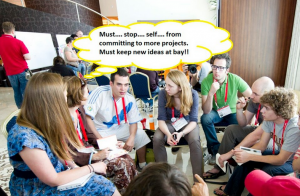
At the moment when a person becomes inspired to make a change, how can an organization support him or her to make that change in their life or to facilitate that change in the lives of others?
Yesterday, during a conversation with my new friend Holly (who also happens to be my doppelganger), I had an inspiration on how to accomplish this. It’s an idea inspired by the collision of several others: A Recipe for Free Range Learning, my experiments with SpacedEd (now Qstream), my long ago experience with Flylady, the concepts of Optimism Bias and activation energy (from the Happiness Advantage), and the “Learn This” Button.
But before I explain the idea, I also have to preserve the story here, because it’s really eerie. On Monday night, my husband tagged me in a picture and added the caption “Must … stop … self … from participating in more projects. Must keep ideas at bay.” For a minute, I believed it was me in the picture. But then I realized I hadn’t met a single person in the group of people in the picture. So, it wasn’t me … but darned if it didn’t look like me. It was really bizarre.
 So on Tuesday, I decided to try to identify the “doppelganger” because she had fooled both my husband and myself with her uncanny resemblance. Lo and behold, when I walked into the Summit Lounge, the same group of people were assembled in a circle having a conversation about one of the actions. I identified the one that looked like me, and made a mental note to find her later. In the opening talk, she walked into the venue and sat down right next to me. I introduced myself and explained that she and I might be doppelgangers (at least from the side profile).
So on Tuesday, I decided to try to identify the “doppelganger” because she had fooled both my husband and myself with her uncanny resemblance. Lo and behold, when I walked into the Summit Lounge, the same group of people were assembled in a circle having a conversation about one of the actions. I identified the one that looked like me, and made a mental note to find her later. In the opening talk, she walked into the venue and sat down right next to me. I introduced myself and explained that she and I might be doppelgangers (at least from the side profile).
 So we started chatting between talks and one thing let to another. Before long, we were talking about the Action Team she was involved with, and she expressed frustration that they seemed to be stuck. When she explained what they were trying to do, something from the previous nights’ talks collided just so with a collection of talks and writings from the past, and a clear path to a solution presented itself. I shared it with Holly, and she agreed that it was a really great solution to the constraints of their problem space: How to turn ideas into action. I suppose that Holly and I were fated to meet, that she was meant to pose this problem to me, and I was meant to generate a solution out of the myriad of random stuff running around in my head.
So we started chatting between talks and one thing let to another. Before long, we were talking about the Action Team she was involved with, and she expressed frustration that they seemed to be stuck. When she explained what they were trying to do, something from the previous nights’ talks collided just so with a collection of talks and writings from the past, and a clear path to a solution presented itself. I shared it with Holly, and she agreed that it was a really great solution to the constraints of their problem space: How to turn ideas into action. I suppose that Holly and I were fated to meet, that she was meant to pose this problem to me, and I was meant to generate a solution out of the myriad of random stuff running around in my head.
Because I’ve been asked to share this strategy at least a half-dozen times in the last 24 hours, it seems work writing down in its entirety to preserve the original details. The fundamental idea is to treat each desired behavioral /action change as fusion of two streams: an action stream and a social coaching stream. Together, this blends to form a set of instructions and the spice for a sort of “action recipe.” Suppose that Holly has just watched an amazing TED video about using less plastic waste, and she wants to take action.
(1) At the moment of inspiration (in this case, the viewing of a TED or TEDx Talk), Holly should have the option to “make a change” or take action” on the screen.
(2) Now she has to decide the size of the impact she wants to make. Ideally, the system would suggest starting small (unless Holly has already taken this action on a smaller level). In the recipe analogy, this is essentially answering the question, “How many cooks are there?”
- One (individual – I want to take action on myself)
- Several (family or a small group of friends)
- Many (an organization or business)
- Everyone (community – I want everyone I can affect to take this action with me)
(3) Suppose Holly does as suggested, and chooses to “start small” with just one cook. Now she would see the recipes written by others who have tagged their action recipes as being linked to this video [note that speakers would be encouraged to write a few recipes if they are speaking about something that is action-appropriate]. Her choices might look something like this:
- Cut down on the amount of plastic bottles you purchase
- Recycle more of the plastic in your life
- [FLIPPED] Recycle more of the plastic in your life in a town without recycling
- [FLIPPED] Recycle more of the plastic in your life in Bulgaria
(4) Holly can click on multiple options on the list (to compare them) and then click on “See ingredients.” The ingredients list would simply tell her what kinds of resources she would need to have or purchase to carry out the action. For example, in order to cut down on the amount of purchased plastic, Holly would need to find or purchase two water bottles (one for home and one for work).
(5) Holly chooses the second option. Now she is asked how she’d like to receive her coaching:
- SMS Texting
- Mobile App
(5) Holly chooses to receive her coaching by SMS, so she follows the directions to set this up, and then the action begins with the first of 30 daily texts (the number of messages would vary based on the type of action and chosen level of impact.
“This is your action coach. The most important thing to do for the next 30 days is keep your water bottle full and in a place where you are likely to grab it when you’re thirsty. Today is your first day of change! Congratulations!”
The second day (and for every day after that for a month), Holly would receive a little message, reminding her to stay on track, and encouraging her to send data back to a global database:
“This is your action coach. How many times did you use your water bottle since my last text? Please reply with the number times you’ve filled up your bottle. Don’t forget keep your water bottle full and in a place where you are likely to grab it when you’re thirsty.”
This string of 30 (or so) messages would be a fixed set of action instructions, written by the author of the recipe. Now for the social coaching aspect. In combination with these messages (a la flylady), the system would provide coaching in real time. For example, Holly replies to the last text with the number “3” … now the system adds her 3 refills to the global count and sends her words of encouragement.
“Wow! Yesterday, a total of 468 water bottles were refilled by people trying to make this change. That’s a total of 468 water bottles that were not purchased. Collectively, that means you saved the energy equivalent of about 3.5 gallons of gasoline. Keep up the good work!”
Another type of social coaching might be inspirational stories, curated by someone keeping an eye on this set of recipes and receiving feedback from those who are nearing the end of their behavioral change.
“Looking for some inspiration to keep your change going? How about watching the short 8-minute film “The Story of Water Bottles while you take a water break today!”
So, fast forward to the end of Holly’s 30-day individual action. During this whole time, she has received 1-2 text messages a day. Always an action prompt, often an inspirational prompt of some sort as well. Every newbie to the action starts on Day 1 of the action prompts, but they just pick up the inspirational social coaching on whatever the coach is pushing out (news stories, facts, global stats for the change project, etc.)
(6) At the end of 30 days, Holly is asked to rate the recipe on a scale of 1-5 (good recipes should eventually rise to the top based on rating and number of times it has been used).
(7) Now the system encourages Holly to consider helping others to make the change. “Would you like to try to influence others to make this change? Your family, your friends, where you work, or your community?” If Holly chooses to “level up” then she subscribes to a new recipe. She is also asked if she’d like to tweak the recipe to make it better (she can “flip” the recipe into a recipe of her own making for a particular audience, perhaps she wants to customize it for teachers, for example)
Recipes at different impact levels would have different ingredients lists, different time frames, and different actions. For example, if you want to change your organization, it would be incredibly important to get buy-in from a leader in the organization. So a first step might be to make an appointment with two potential “champions” for the cause, and show them the video that inspired you.
Of course, recipes would be tagged for keywords and to link them to particular content (videos, books, etc.)
It is, in my opinion, crucial that the behavior change involves a “push” of coaching to the participant (too easy to forget you meant to change) and that it includes not just an action process, but a personal element of coaching.
Now … I’m tired and that’s all I’m writing about this tonight, because I need to get at least ONE night of solid sleep at this incredibly awesome TEDxSummit event.



